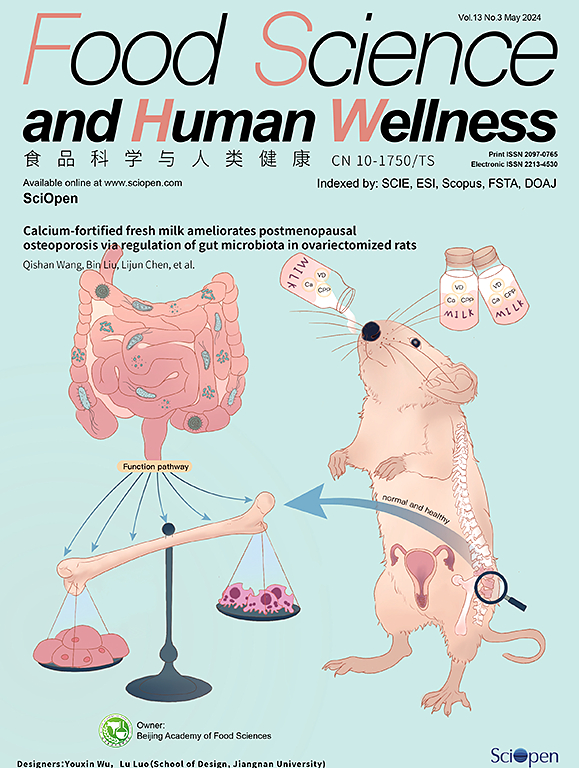母亲膳食模式与中国哺乳期妇女和产后6个月婴儿骨密度的相关性:利用2018-2019年数据进行的前瞻性研究
IF 7.4
1区 农林科学
Q1 FOOD SCIENCE & TECHNOLOGY
引用次数: 0
摘要
这项队列研究旨在探讨中国哺乳期母婴的母亲膳食模式(DPs)与骨骼健康之间的关系。我们招募了 150 名产后 1 个月的哺乳期妇女。我们收集了受试者钙骨的估计骨矿物质密度(eBMD)和膳食摄入信息。随访 5 个月后,再次测量母亲及其婴儿的 eBMD。采用因子分析来确定母亲的DP。一般线性模型用于评估母体DP与母体eBMD损失或婴儿eBMD之间的关系。在调整了所有潜在的协变量后,因子 2(全谷物、块茎类、杂豆、大豆和大豆制品、海藻类和坚果的高摄入量)与母体 eBMD 的变化呈正相关(β = 0.16,95 % CI:0.005,0.310)。因子 3(软饮料、油炸食品和膨化食品的高摄入量)与产妇 eBMD 的变化呈反向关系(β = -0.22,95 % CI:-0.44,0.00)。母体 eBMD 的变化与 6 个月婴儿的 eBMD 呈正相关(β = 0.34,95 % CI:0.017,0.652)。总之,因子 2 可能有助于维持哺乳期妇女的 eBMD,而因子 3 则可能加剧母体 eBMD 的损失。此外,母体 eBMD 的变化与 6 个月婴儿的 eBMD 呈正相关。本文章由计算机程序翻译,如有差异,请以英文原文为准。
Maternal dietary patterns associated with bone density in Chinese lactating women and infants at 6 months postpartum: a prospective study using data from 2018–2019
This cohort study was designed to explore the relationship between maternal dietary patterns (DPs) and bone health in Chinese lactating mothers and infants. We recruited 150 lactating women at 1-month postpartum. The estimated bone mineral density (eBMD) of subjects’ calcanei and the information on dietary intake were collected. After 5-month follow-up, the eBMD of mothers and their infants were measured again. Factor analysis was applied to determine maternal DPs. General linear models were used to evaluate the association between maternal DPs and maternal eBMD loss or infants’ eBMD. With all potential covariates adjusted, Factor 2 (high intake of whole grains, tubers, mixed beans, soybeans and soybean products, seaweeds, and nuts) showed a positive association with the changes of maternal eBMD (β = 0.16, 95 % CI: 0.005, 0.310). Factor 3 (high intake of soft drinks, fried foods, and puffed foods) was inversely correlated with the changes of maternal eBMD (β = –0. 22, 95 % CI: -0.44, 0.00). The changes of maternal eBMD were positively associated with 6-month infants’ eBMD (β = 0.34, 95 % CI: 0.017, 0.652). In conclusion, Factor 2 might contribute to the maintenance of eBMD in lactating women, while Factor 3 could exacerbate maternal eBMD loss. Additionally, the changes of maternal eBMD presented a positive correlation with 6-month infants’ eBMD.
求助全文
通过发布文献求助,成功后即可免费获取论文全文。
去求助
来源期刊

Food Science and Human Wellness
Agricultural and Biological Sciences-Food Science
CiteScore
8.30
自引率
5.70%
发文量
80
审稿时长
28 days
期刊介绍:
Food Science and Human Wellness is an international peer-reviewed journal that provides a forum for the dissemination of the latest scientific results in food science, nutriology, immunology and cross-field research. Articles must present information that is novel, has high impact and interest, and is of high scientific quality. By their effort, it has been developed to promote the public awareness on diet, advocate healthy diet, reduce the harm caused by unreasonable dietary habit, and directs healthy food development for food industrial producers.
 求助内容:
求助内容: 应助结果提醒方式:
应助结果提醒方式:


